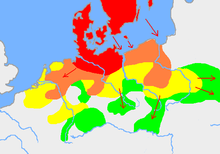East Germanic languages
| East Germanic | |
|---|---|
| Geographic distribution | Varying depending on time (4th-18th centuries), currently none (all languages are extinct) Until late 4th century:[1] Central and eastern Europe (as far as Crimea) late 4th—early 10th centuries:[2] Much of southern, western, southeastern, and eastern Europe (as far as Crimea) and North Africa early 10th—late 18th centuries:[3] Isolated areas in eastern Europe (as far as Crimea) |
| Linguistic classification | Indo-European
|
| Subdivisions |
|
| ISO 639-5 | gme |
| Glottolog | east2805 |
 The distribution of the primary Germanic languages in Europe c. AD 1:
North Germanic
North Sea Germanic, or Ingvaeonic
Weser-Rhine Germanic, or Istvaeonic
Elbe Germanic, or Irminonic
East Germanic † | |
The East Germanic languages, also called the Oder–Vistula Germanic languages, are a group of extinct Germanic languages spoken by East Germanic peoples. East Germanic is one of the primary branches of Germanic languages, along with North Germanic and West Germanic.
The only East Germanic language of which texts are known is Gothic, although a word list and some short sentences survive from its relative Crimean Gothic. Other East Germanic languages include Vandalic and Burgundian, though the only remnants of these languages are in the form of isolated words and short phrases. Crimean Gothic is believed to have survived until the 18th century in isolated areas of Crimea.
History[]

East Germanic was presumably native to the north of Central Europe, especially modern Poland, and likely even the first branch to split off from Proto-Germanic in the first millennium BCE.
For many years, the least controversial theory of the origin of the Germanic (and East Germanic) languages was the so-called Gotho-Nordic hypothesis: that they originated in the Nordic Bronze Age of Southern Scandinavia and along the coast of the northernmost parts of Germany.[4]
By the 1st century CE, the writings of Pomponius Mela, Pliny the Elder, and Tacitus indicate a division of Germanic-speaking peoples into large groupings with shared ancestry and culture. (This division has been taken over in modern terminology about the divisions of Germanic languages.)
Based on accounts by Jordanes, Procopius, Paul the Deacon and others, as well as linguistic, toponymic, and archaeological evidence, the East Germanic tribes, the speakers of the East Germanic languages related to the North Germanic tribes, had migrated from Scandinavia into the area lying east of the Elbe.[5] In fact, the Scandinavian influence on Pomerania and today's northern Poland from c. 1300–1100 BCE (Nordic Bronze Age sub-period III) onwards was so considerable that this region is sometimes included in the Nordic Bronze Age culture (Dabrowski 1989:73).
There is also archaeological and toponymic evidence which has been taken as suggesting that Burgundians lived on the Danish island of Bornholm (Old Norse: Burgundaholmr), and that Rugians lived on the Norwegian coast of Rogaland (Old Norse: Rygjafylki).
Groups[]
This section does not cite any sources. (March 2018) |
Possible East Germanic-speaking tribes include:
- Bastarnae
- Burgundians
- Goths
- Crimean Goths
- Gepids
- Greuthungi
- Ostrogoths
- Thervingi
- Visigoths
- Heruli
- Lemovii
- Lugii
- Rugians
- Sciri
- Vandals
- Vidivarii
See also[]
- Ingvaeonic languages
- Irminonic languages
- Istvaeonic languages
- North Germanic languages
- West Germanic languages
- Balto-Slavic languages
Notes and references[]
- ^ From origins until the beginning of the Migration Period.
- ^ From the onset of the Migration Period until extinctions of major East Germanic languages with the last one occurring in the early 10th century.
- ^ From the last major extinction until the 18th century demise of Crimean Gothic.
- ^ John T. Koch (2020). "CELTO-GERMANIC, Later Prehistory and Post-Proto-Indo-European vocabulary in the North and West", p. 38
- ^ The Penguin Atlas of World History, Hermann Kinder and Werner Hilgemann; translated by Ernest A. Menze; with maps designed by Harald and Ruth Bukor. Harmondsworth: Penguin Books. ISBN 0-14-051054-0, 1988. Volume 1, p. 109.
- Dabrowski, J. (1989) Nordische Kreis und Kulturen Polnischer Gebiete. Die Bronzezeit im Ostseegebiet. Ein Rapport der Kgl. Schwedischen Akademie der Literatur, Geschichte und Altertumsforschung über das Julita-Symposium 1986. Ed Ambrosiani, Björn Kungl. Vitterhets Historie och Antikvitets Akademien. Konferenser 22. Stockholm. ISBN 91-7402-203-2
- Demougeot, E. La formation de l'Europe et les invasions barbares, Paris: Editions Montaigne, 1969–74.
- Kaliff, Anders. 2001. Gothic Connections. Contacts between eastern Scandinavia and the southern Baltic coast 1000 BCE – 500 CE.
- Musset, L. Les invasions: les vagues germanique, Paris: Presses universitaires de France, 1965.
- Nordgren, I. 2004. Well Spring of The Goths. About the Gothic Peoples in the Nordic Countries and on the Continent.
- East Germanic languages
- Extinct languages of Europe
- Extinct Germanic languages